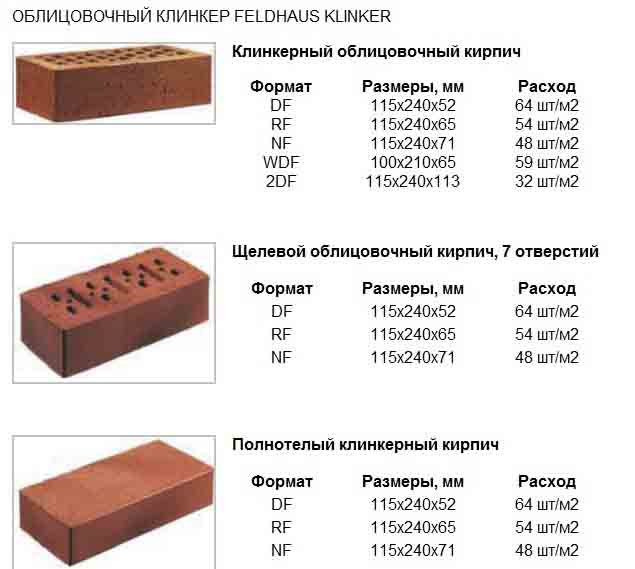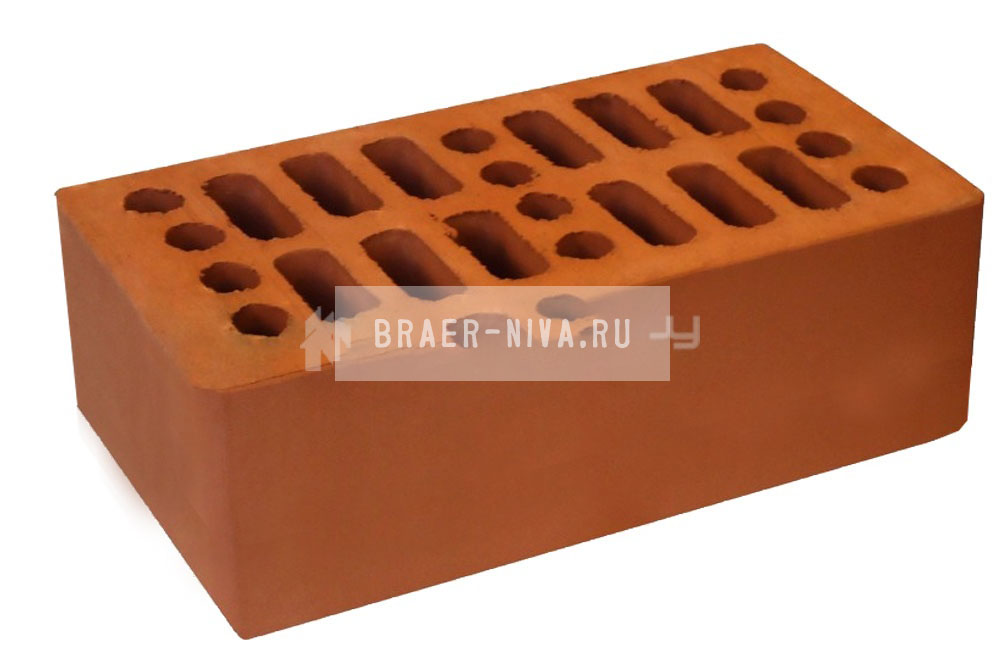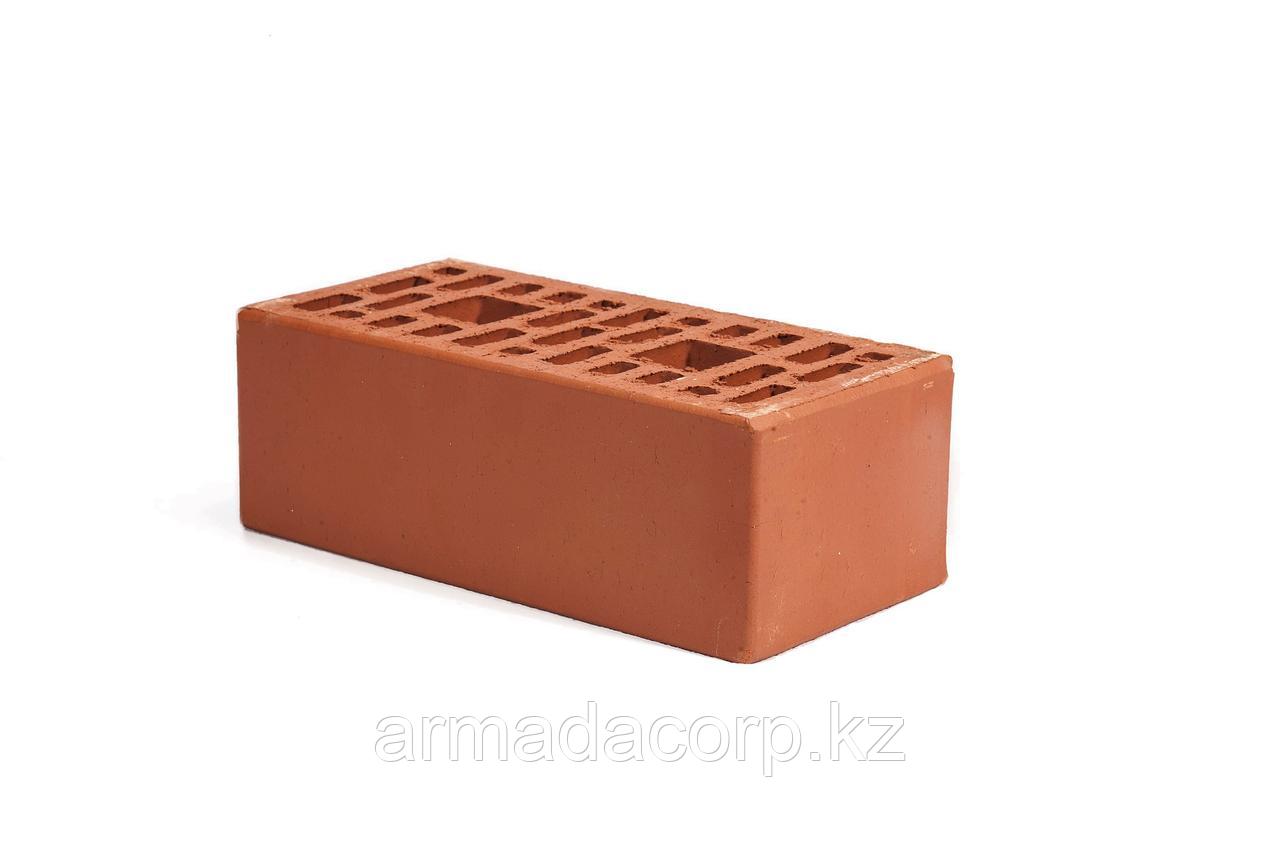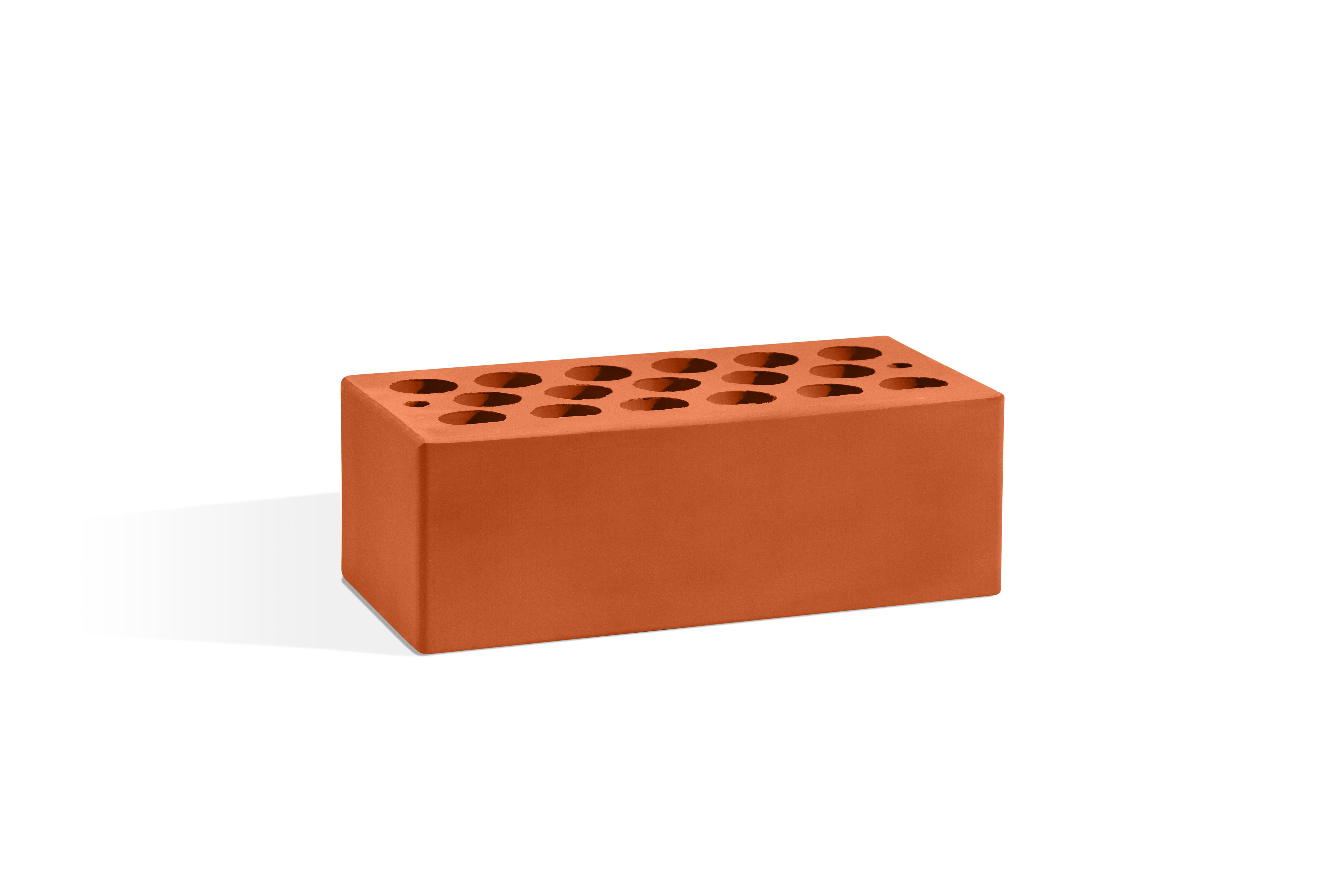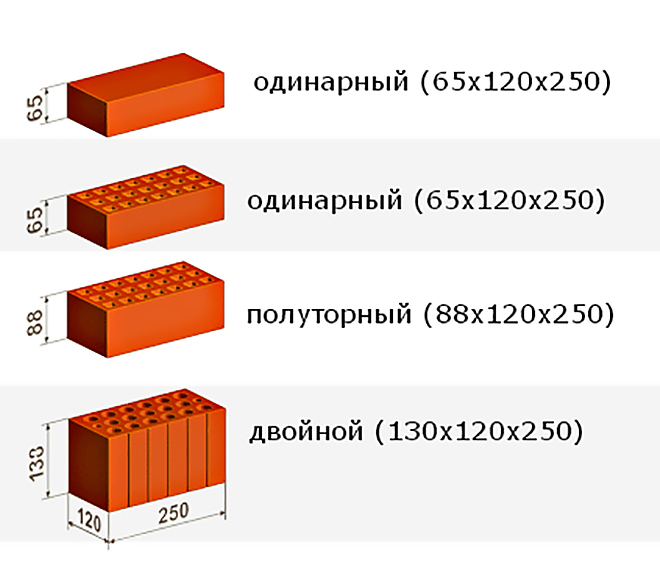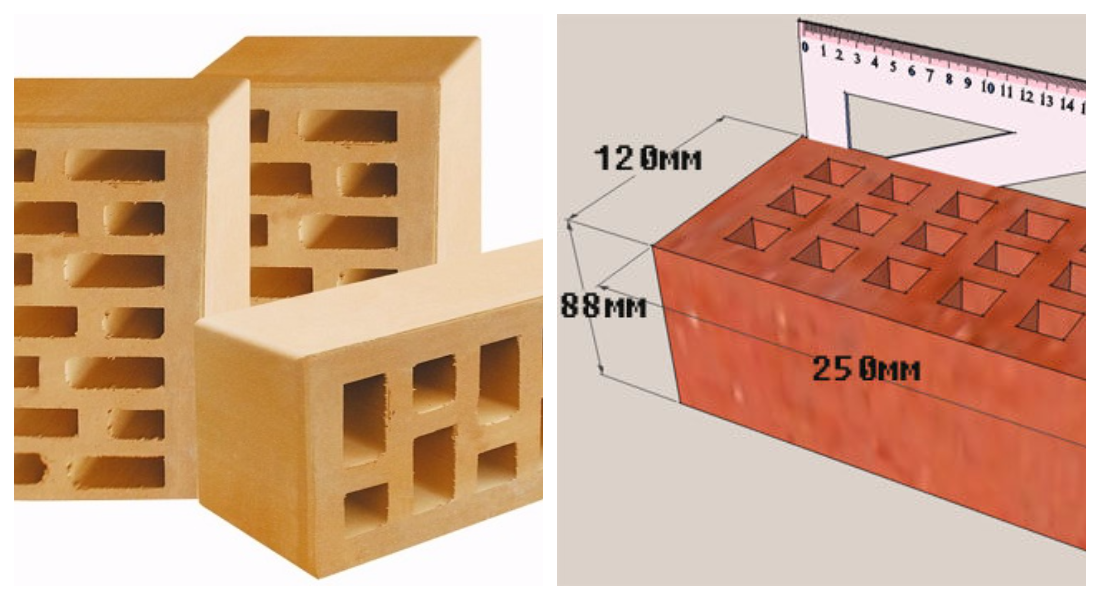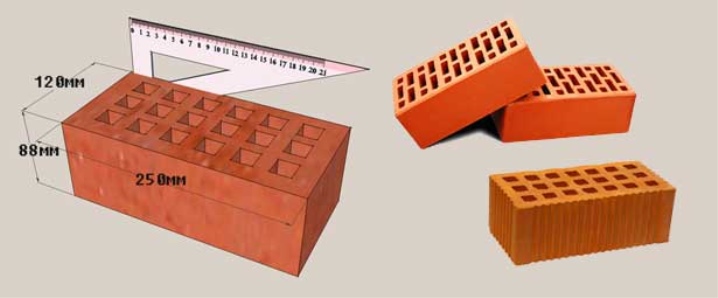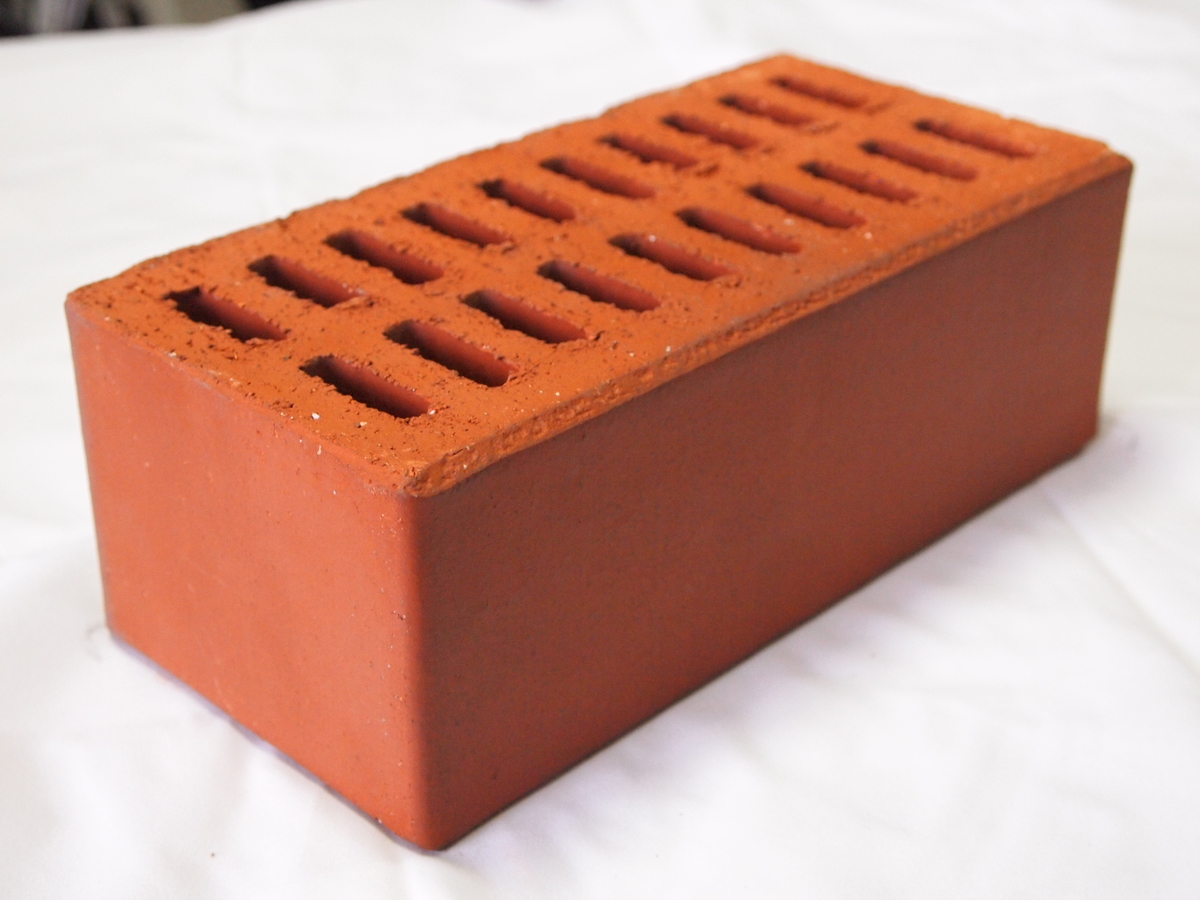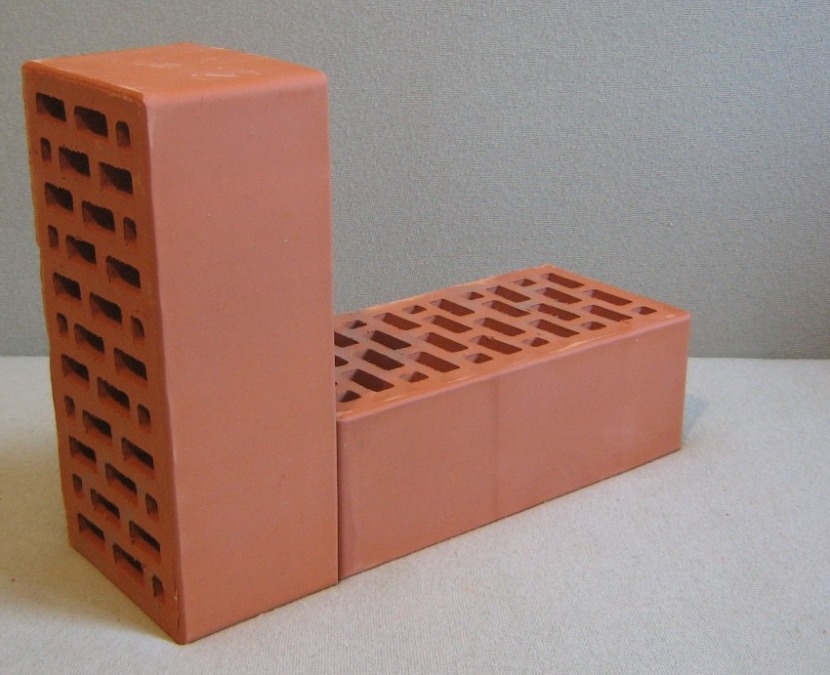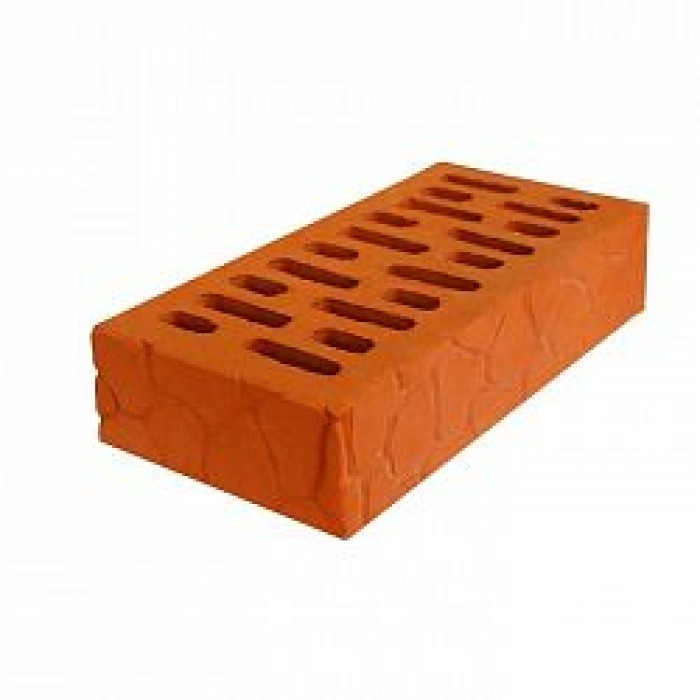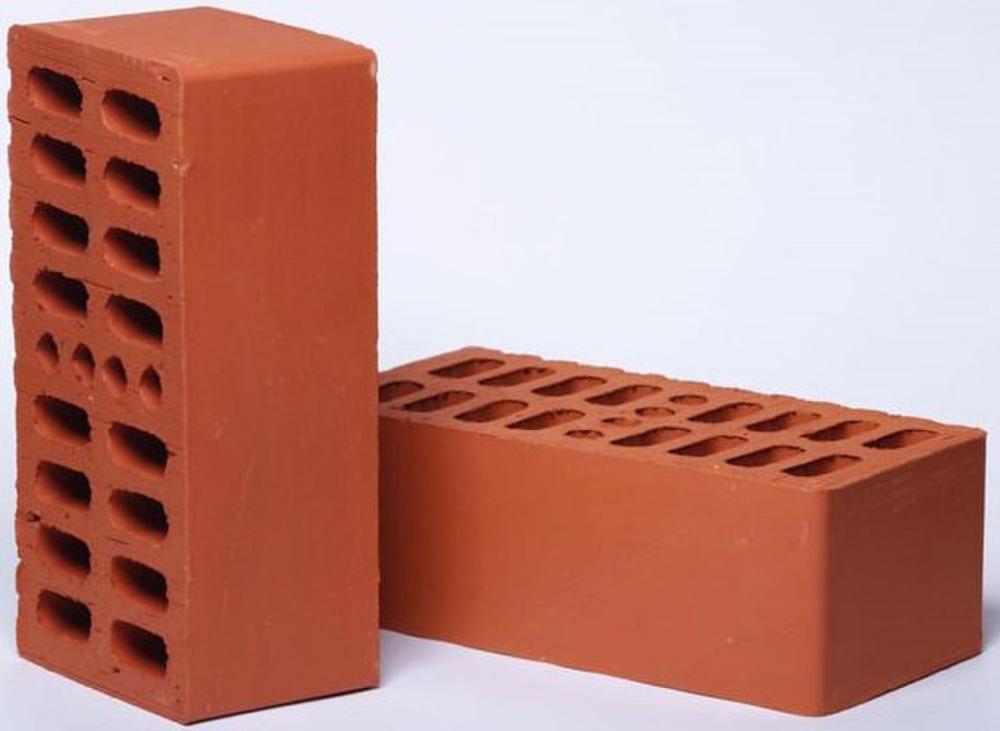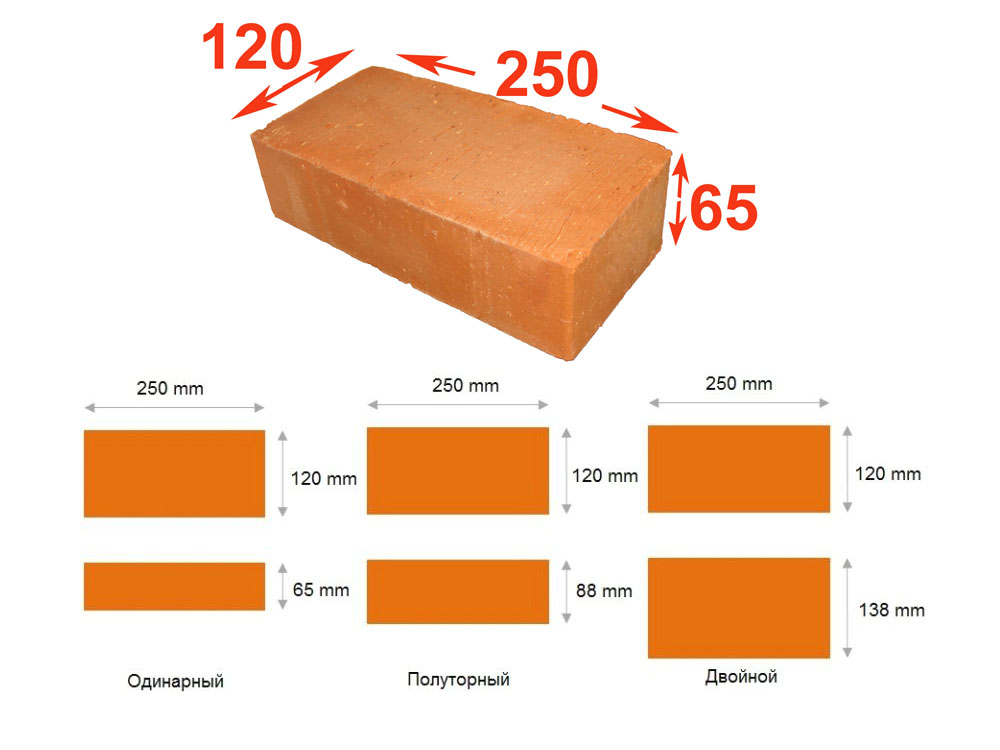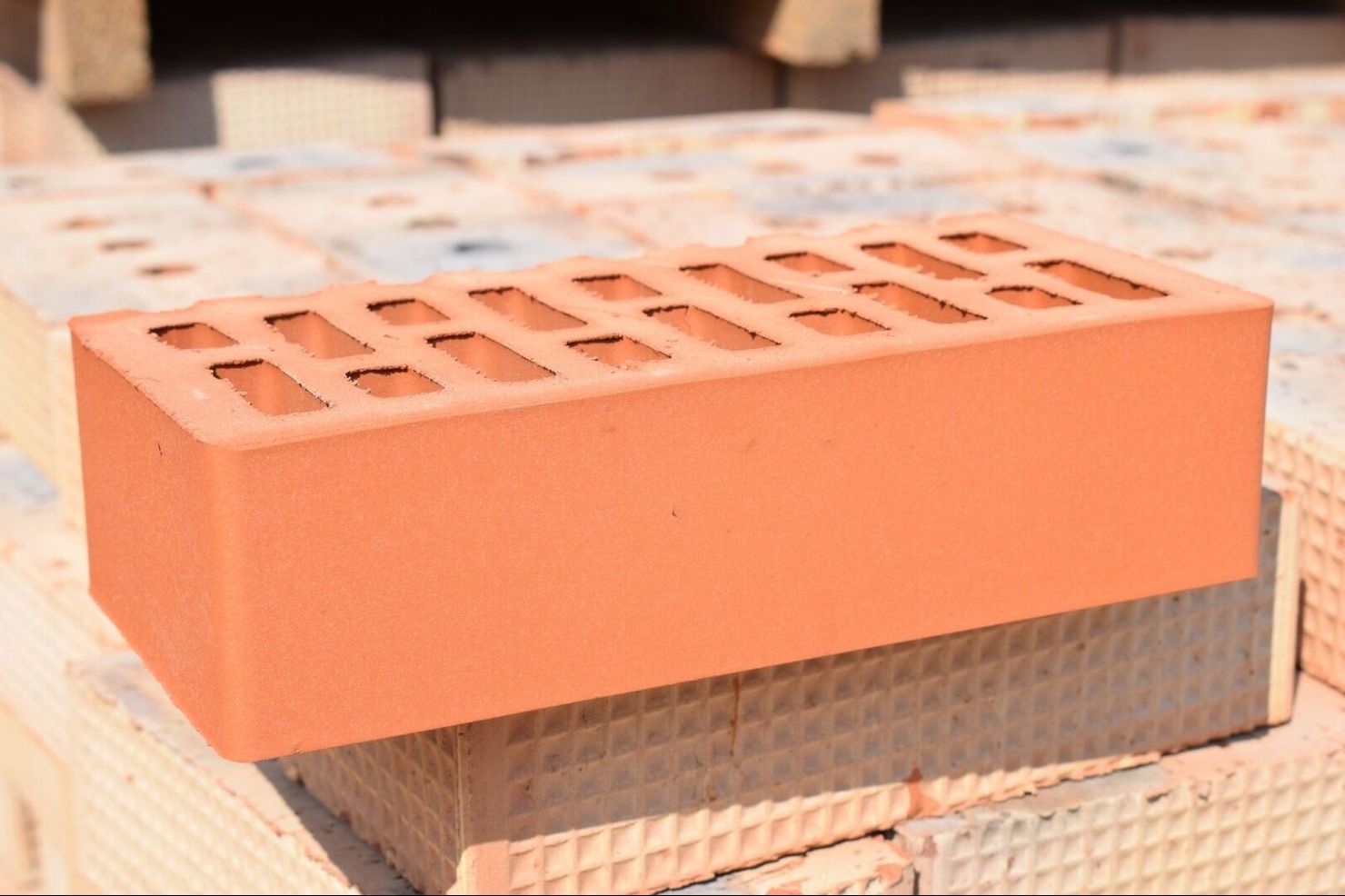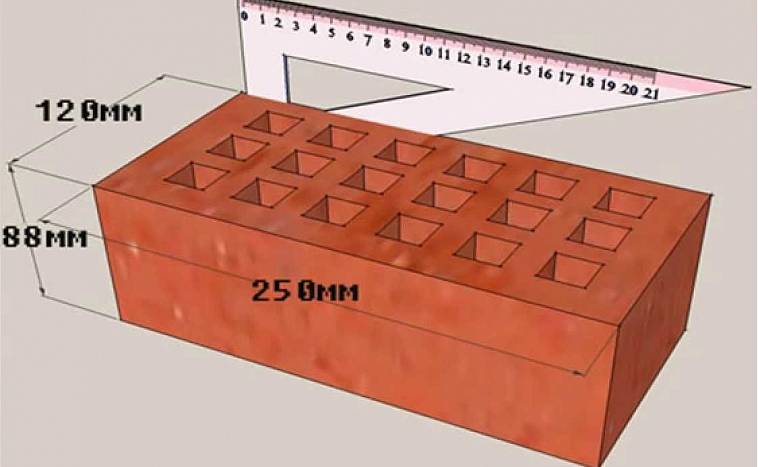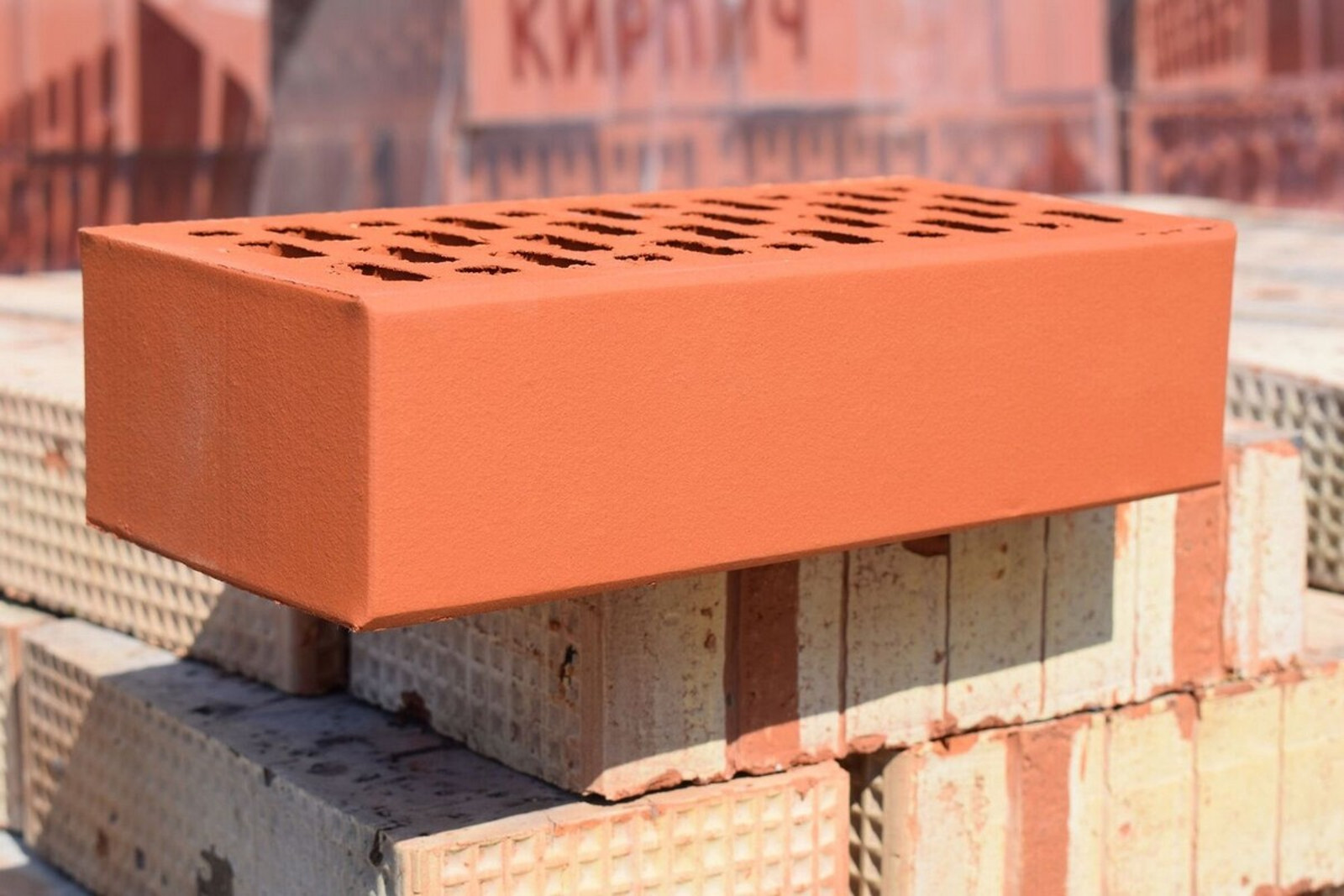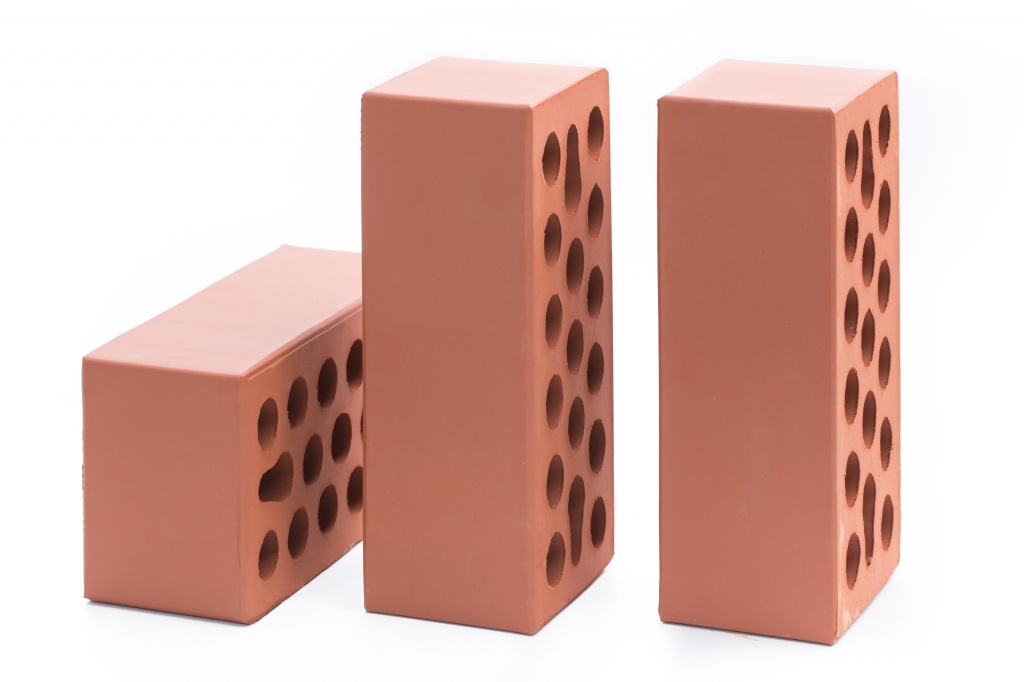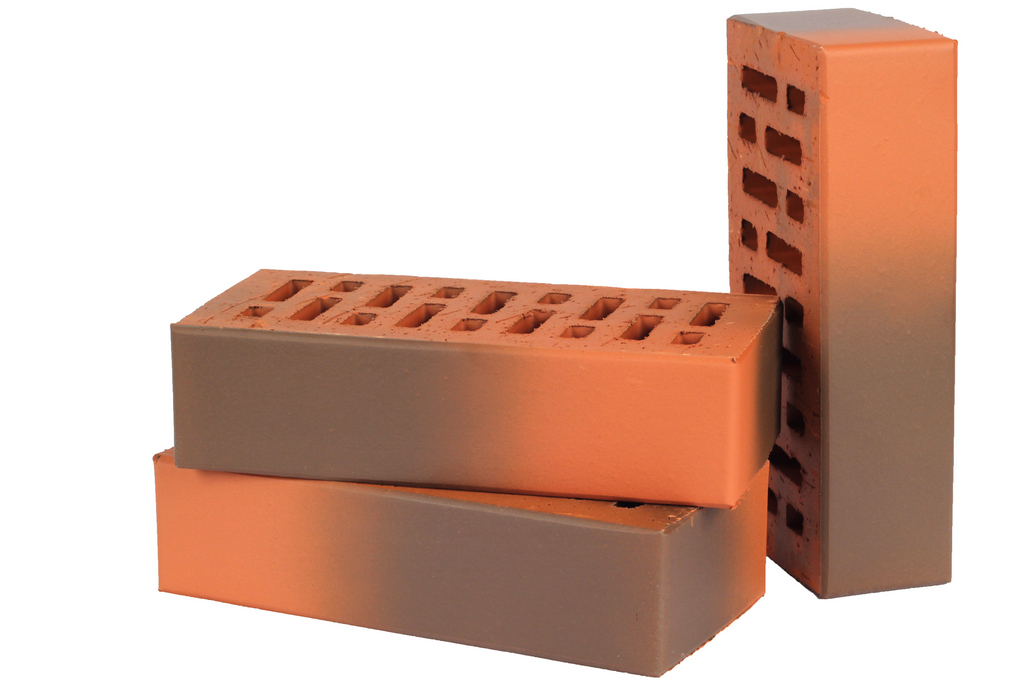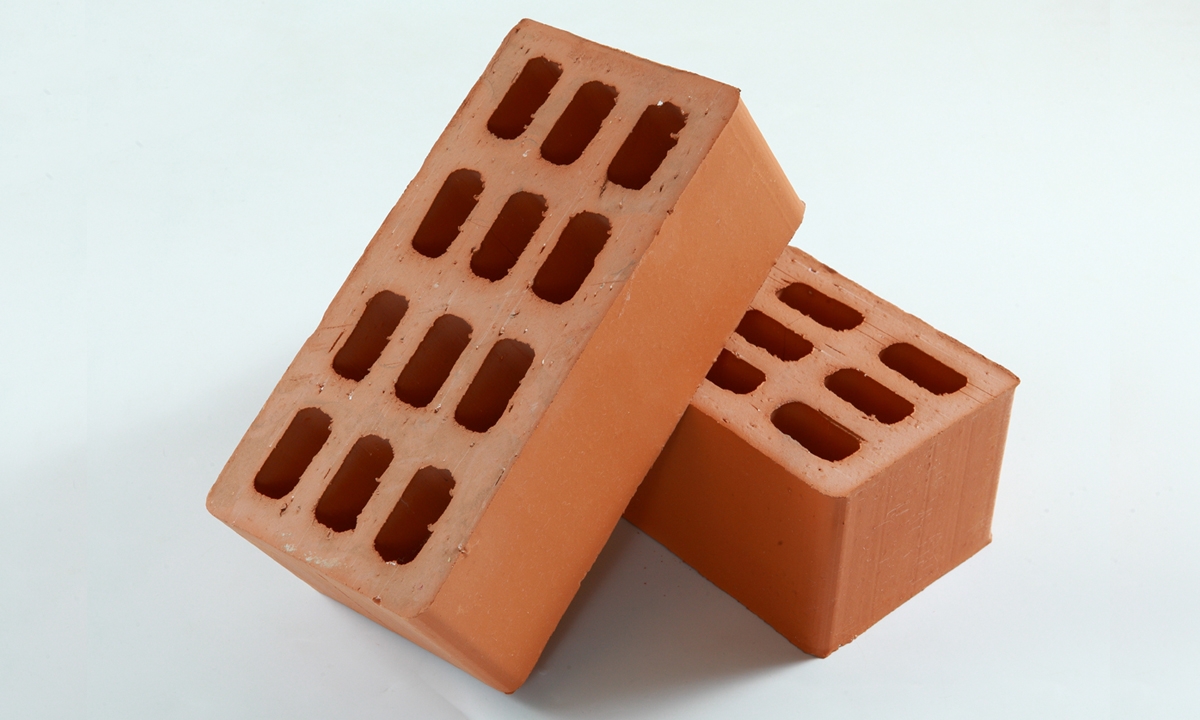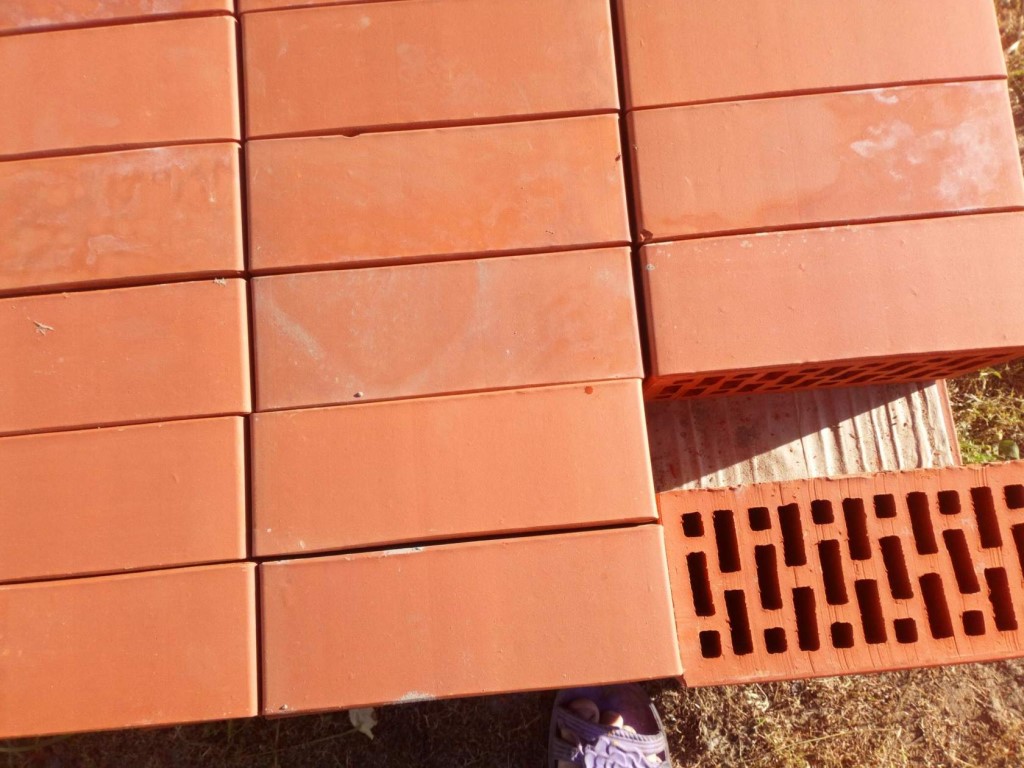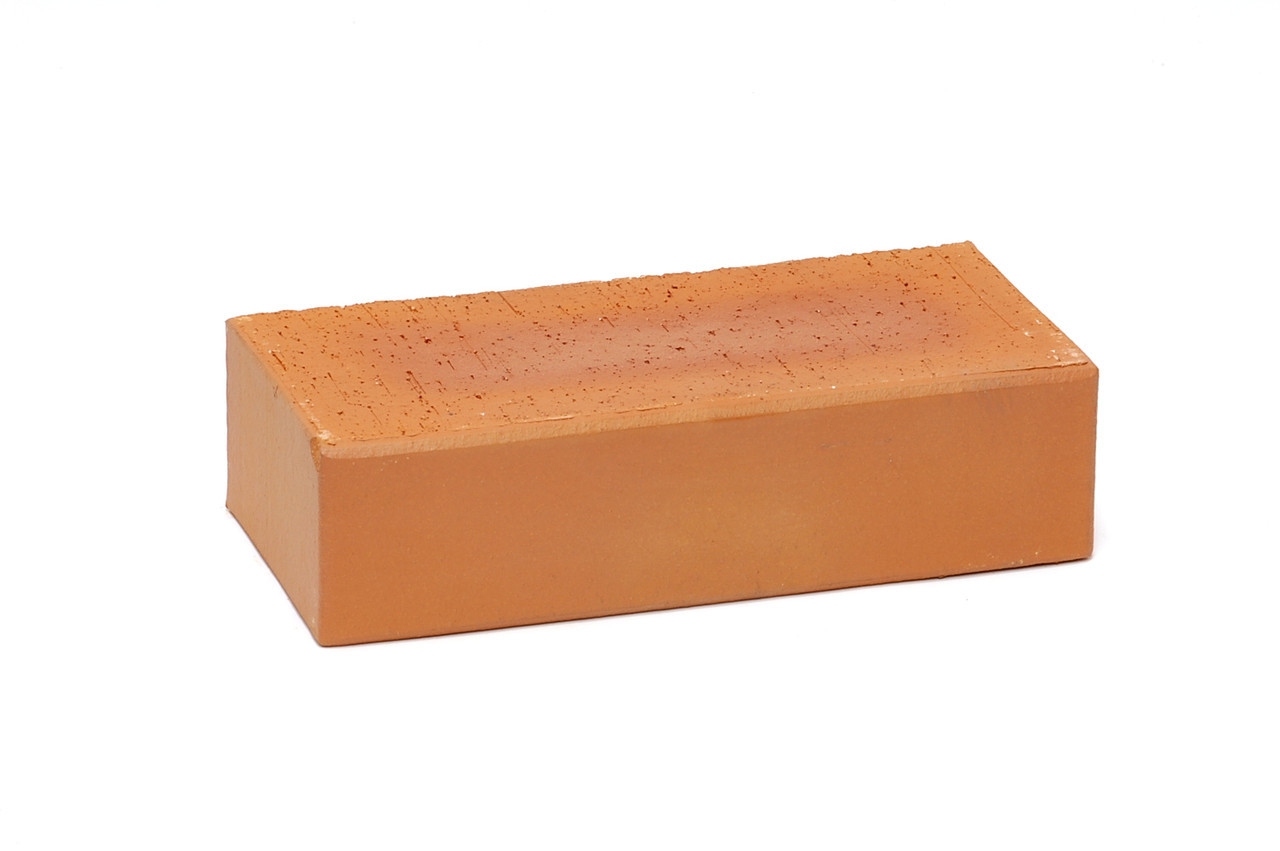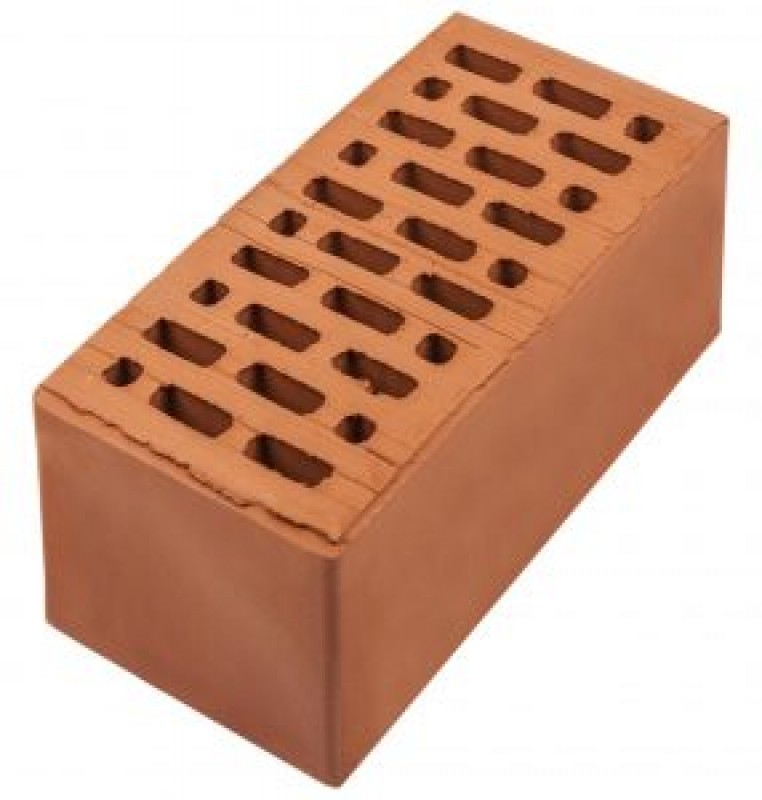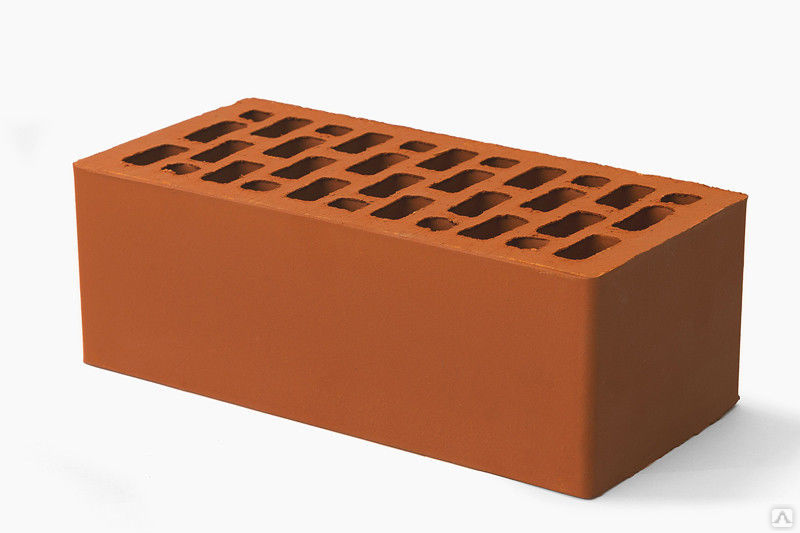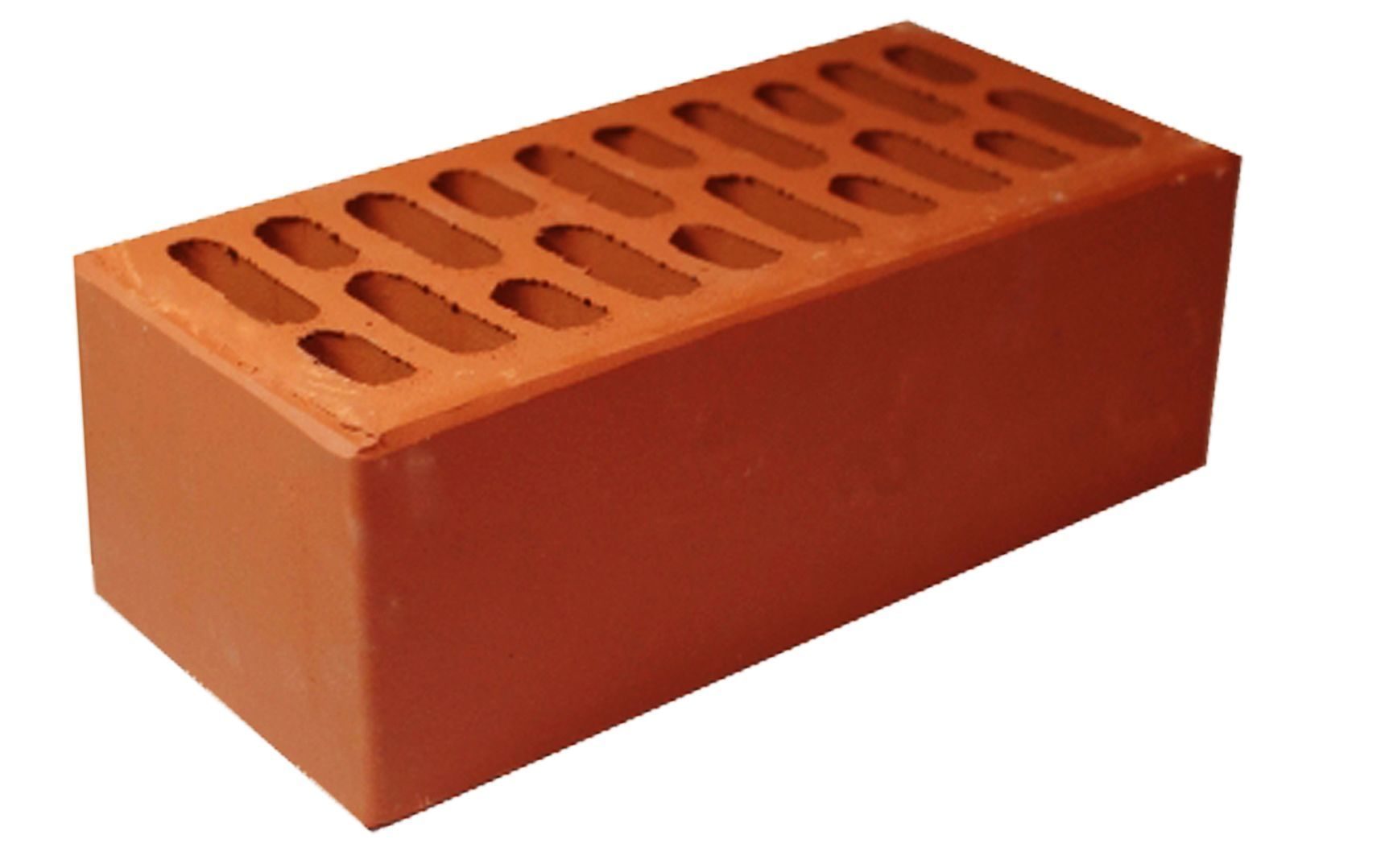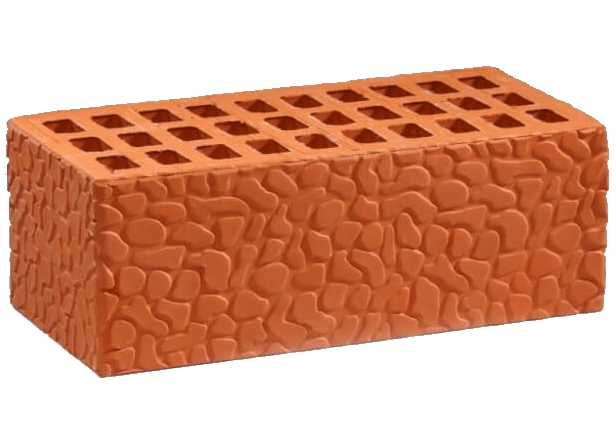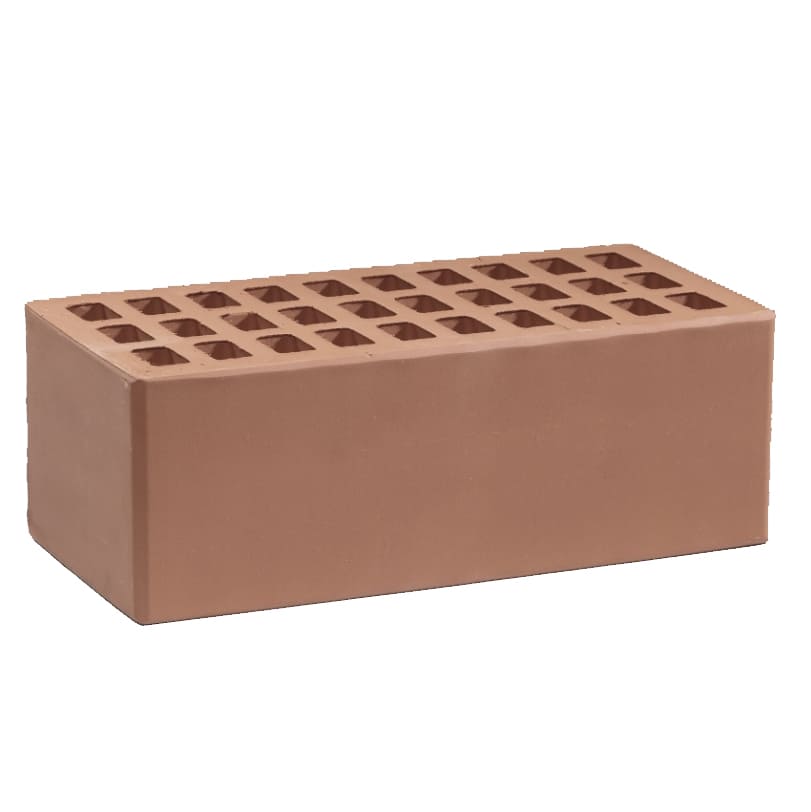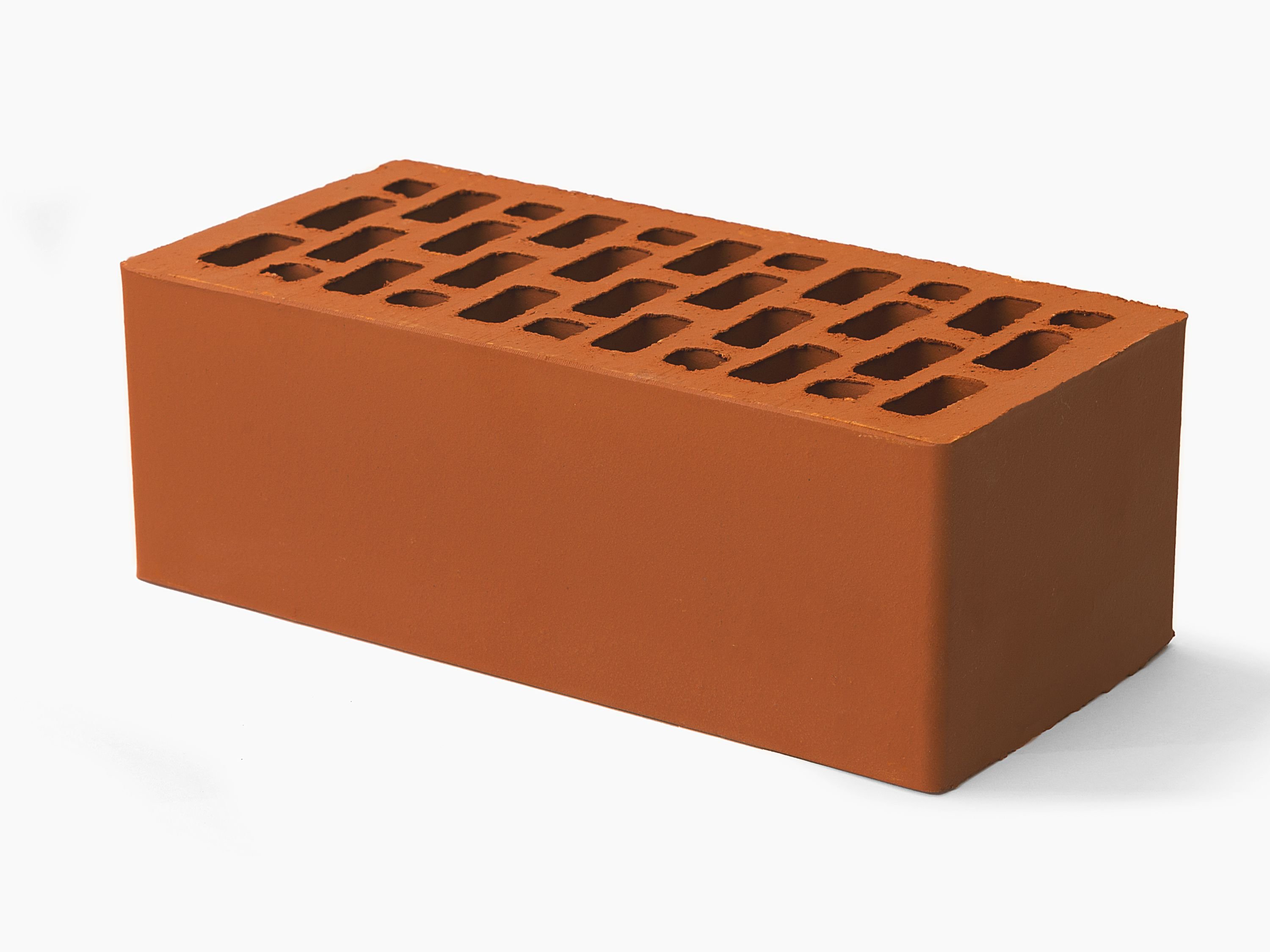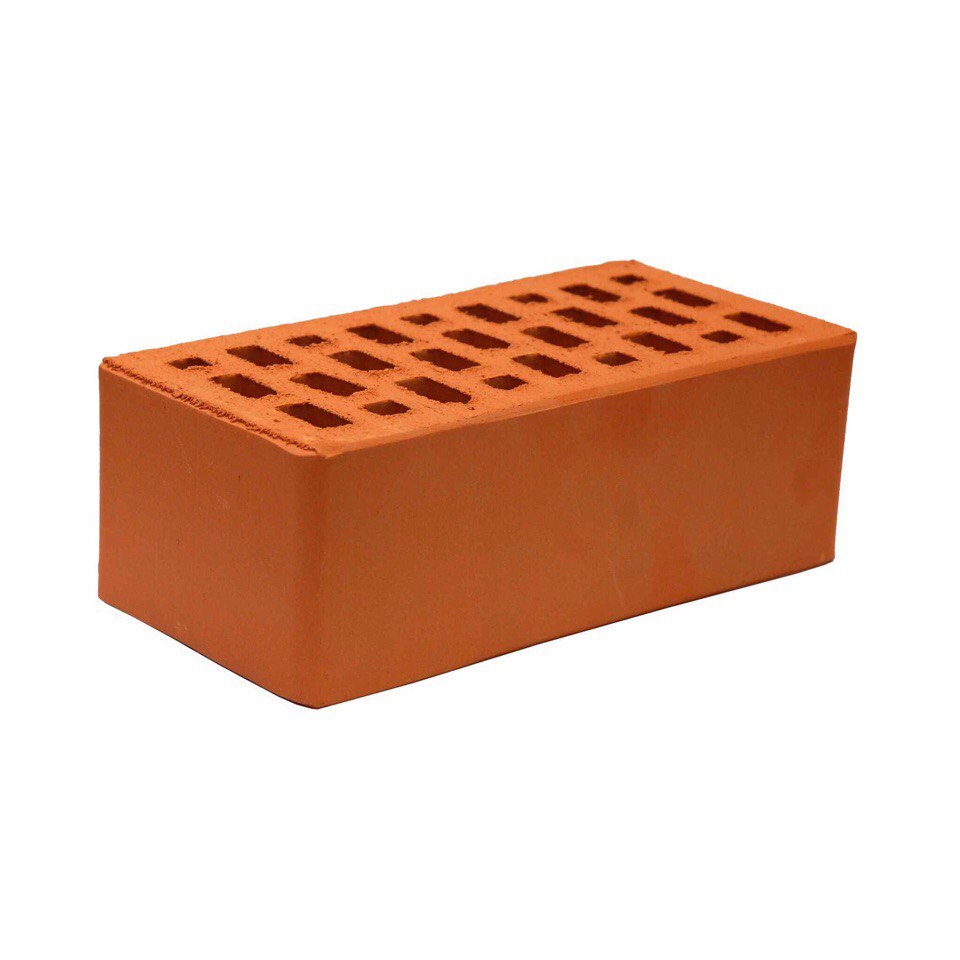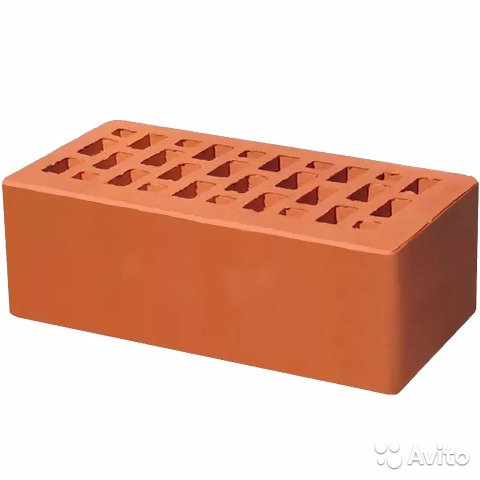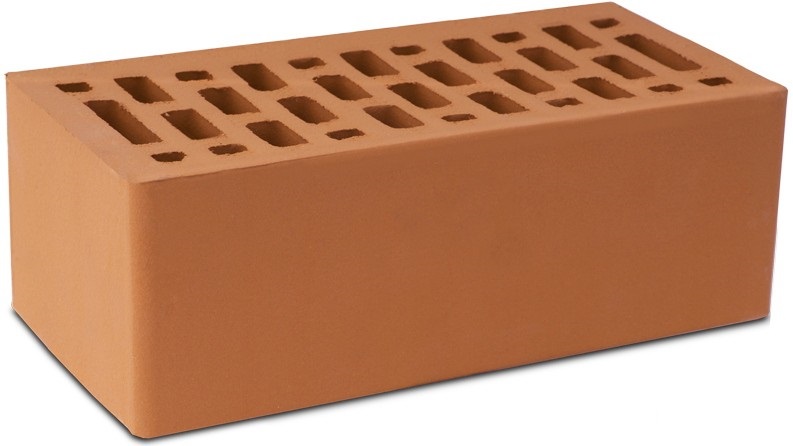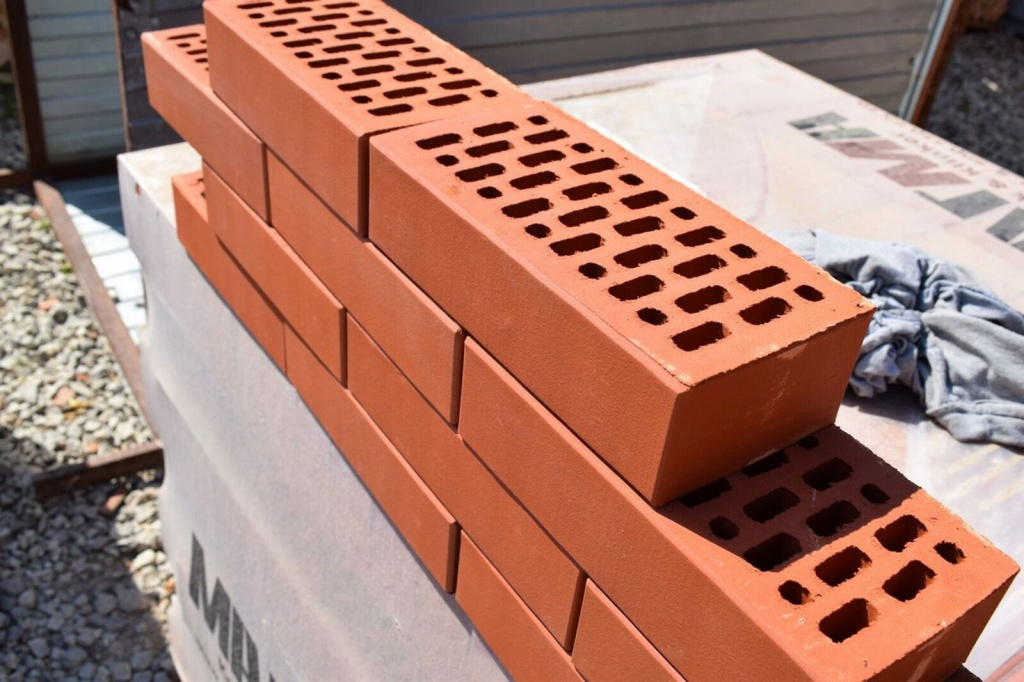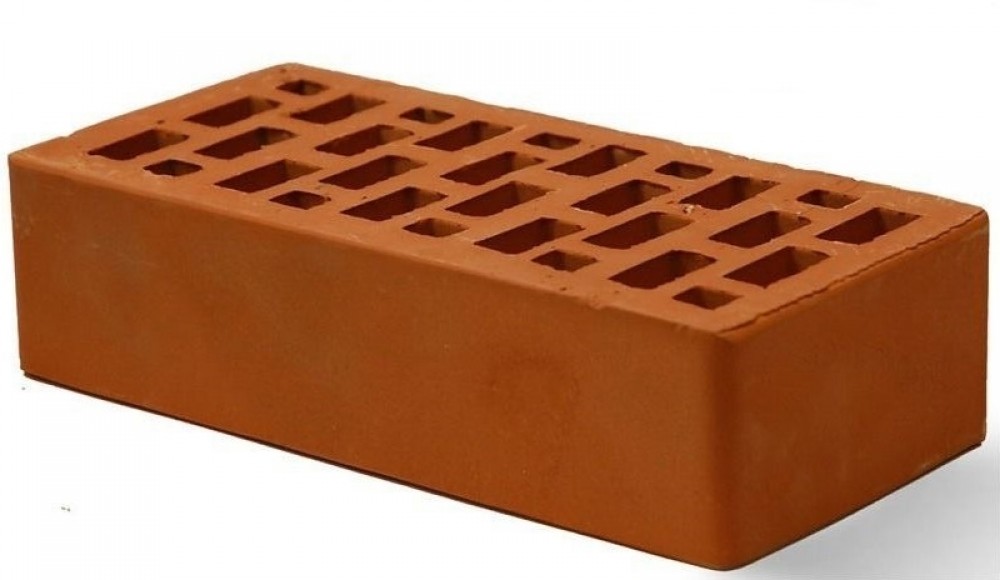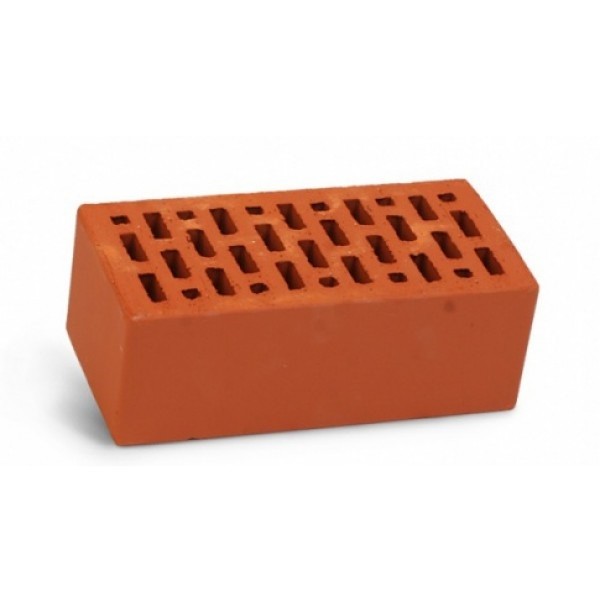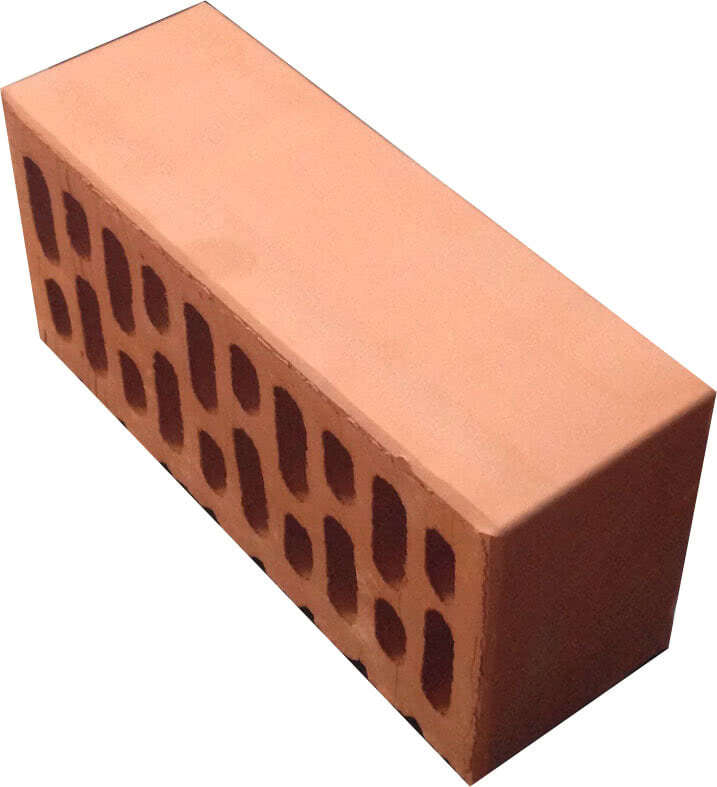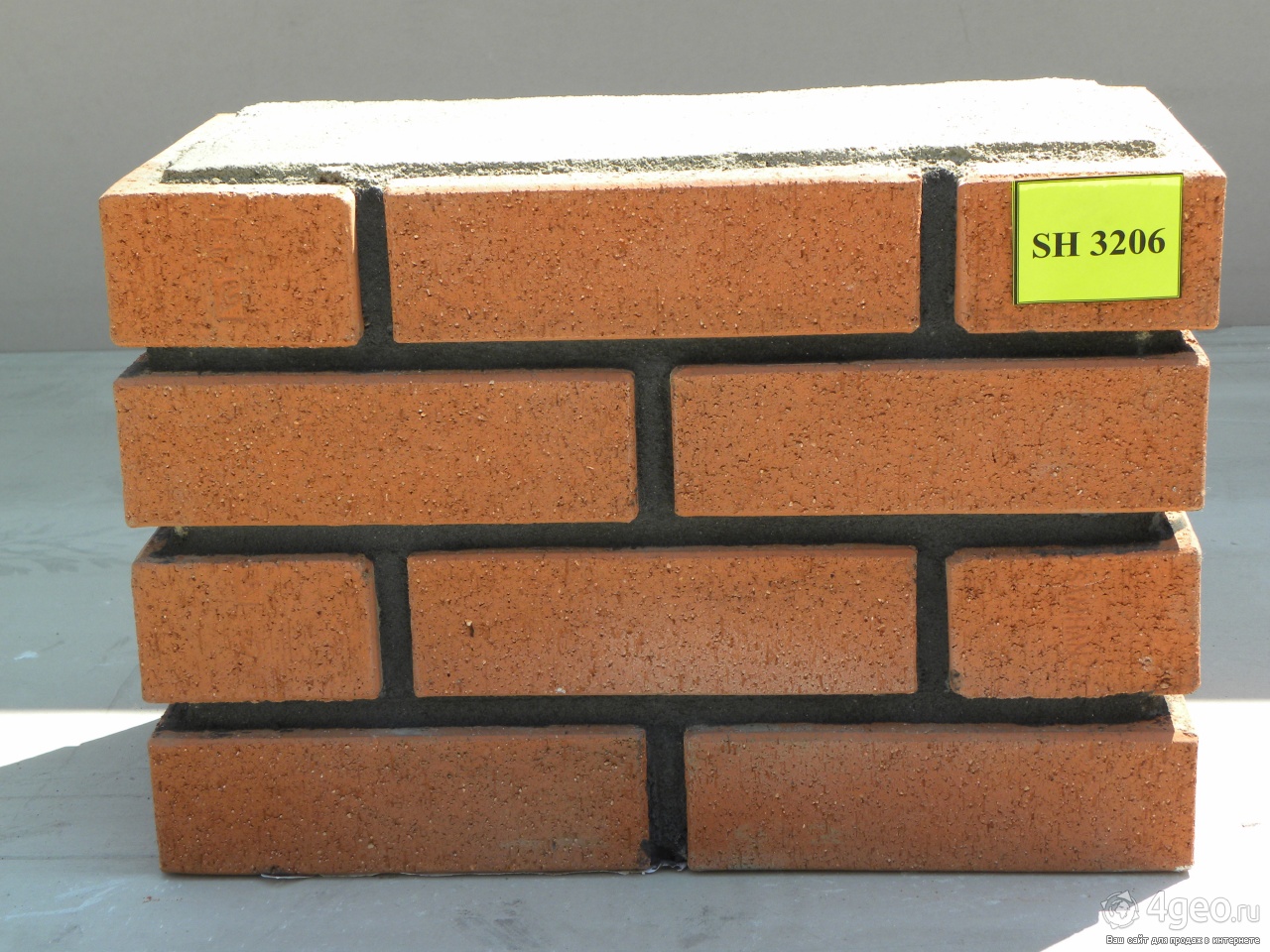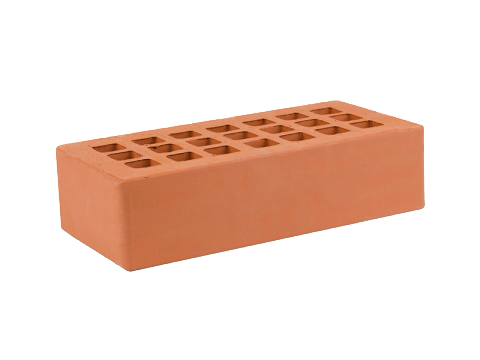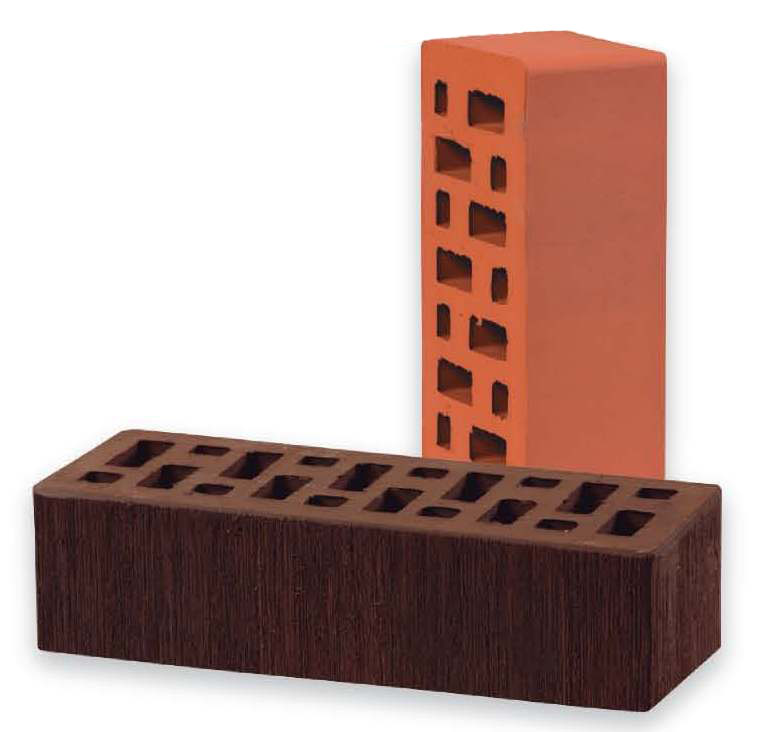Varieties
The classification of red solid bricks occurs according to a number of signs, the main of which is the purpose of the material. According to this criterion, ceramic models are divided into several types.
Ordinary brick
It is the most popular and demanded type and is used for the construction of foundations, load-bearing walls and interior partitions. The raw material for the brick is ordinary red clay, and it is made in two ways.
- The first is called the semi-dry pressing method and consists in the formation of workpieces from clay with low moisture content. The pressing takes place under very high pressure, so the fired raw material sets quickly enough, and a dense and hard material is obtained at the exit.
- The second method is called the method of plastic formation and consists in the design of the raw material by means of a belt press with further drying and firing of the blanks. It is in this way that most modifications of red brick are made.
Fireclay brick
It bears the name of refractory and is made of fireclay clay. Its share in the total mass of the product reaches 70%, which makes the material practically invulnerable to open fire and allows the masonry to withstand its impact for five hours. For comparison, it should be noted that reinforced concrete structures are able to withstand a flame for two hours, and metal structures - from 30 minutes to an hour.
Facing brick
It has a smooth or corrugated surface and is widely used for finishing facades of buildings and interiors.
Shaped or shaped bricks
It is produced in non-standard forms and is used in the construction and decoration of small architectural forms, including arches, columns and pillars.
Clinker brick
It is the most durable type and is widely used for paving sidewalks and roadways. The clinker has a long service life, high strength reaching the M1000 index, and increased frost resistance, which allows the material to withstand up to 100 freezing cycles.
In addition to their functional purpose, ceramic full-bodied models differ in size. According to the accepted standards of GOSTs, bricks are produced in thickness in single, one-and-a-half and double versions. The most common sizes are single (250x120x65 mm) and one and a half (250x120x88 mm). Dimensions of double bricks reach 250x120x140 mm.
However, in addition to products with standard sizes, there are often options with unconventional dimensions. These include eurobricks with dimensions of 250x85x65 mm, modular specimens with dimensions of 288x138x65 mm, as well as non-dimensional models with lengths of 60, 120 and 180 mm and a height of up to 65 mm. Bricks of foreign manufacturers have slightly different dimensions, of which the most popular are 240x115x71 and 200x100x65 mm.
In the next video, you will find a film about the technological process of the production of clay bricks.
Silicate
Most people who are involved in construction understand that the best product is red and silicate white bricks. What is the difference between them? These materials are similar in size and shape.
In the production of red products, clay is used, and for white products, sand and lime. For this reason, the properties of these products are completely different. The sizes of white sand-lime bricks can be of three types:
The process of making a white product involves the use of autoclave synthesis, as a result of which it arose much later than red. To obtain it, a mixture of lime and clay is pressed.
The size of the red brick is indicated in the article.
Then it is formed into a brick, which is then steamed in autoclaves under pressure and high temperature indicators. Thanks to the addition of various pigments, it is possible to give the product a wide variety of colors and properties.
Whites can be of two types: full-bodied and hollow. The second type is characterized by a lighter weight, as a result of which it allows a minimum of heat to pass through. Such a stone is considered the best option for the construction of a structure, where it is required to reduce the pressure on the base.
The video shows the dimensions of a one-and-a-half facing brick:
The dimensions of sand-lime bricks can be different, it all depends on the purpose:
- standard;
- one and a half;
- double.
The dimensions of a silicate sample are rarely used by designers. As a rule, double and one-and-a-half products are used. Regardless of size, sand-lime brick can be hollow and solid. When the material is void, then its voids take on a through character or are concentrated perpendicularly relative to the bed. The size of the white sand-lime brick allows you to build a solid and reliable house.
Table 2 - The size of the silicate
No. 9. Brick size
After the color, type and nature of the filling has been determined, the next question arises - what size of brick is needed. According to GOST 530-2007, a standard brick has dimensions of 250 * 120 * 65 mm, and all standard sizes are determined relative to it:
- single brick - this is the same standard one, it is the most versatile, it is used both for masonry and for cladding, it is convenient to work with this, since it fully corresponds to a person's hands;
- one and a half size 250 * 120 * 88 mm is used when laying massive structures and allows you to significantly save time;
- double size 250 * 120 * 138 is rarely full-bodied, and hollow is used in lightweight masonry;
- narrow size 250 * 60 * 65 is used only for decorative purposes;
- a thin one measuring 250 * 22 * 65 mm is already, in fact, a tile, the scope of which is facing work;
- there are also bricks "euro" (0.7 from the standard thickness), modular (1.3 from the standard thickness), incomplete brick and other exotic standard sizes, which are rarely used in construction.
Historically, the edges of the brick are called the bed (the working largest part of the product), the spoon part (the long side edge) and the poke (the smallest edge). Some manufacturers and stores use exactly these concepts, so it will not be superfluous to remember them.
Knowing which structure (or decoration) is to be completed, given its size and dimensions of the most suitable type of brick, you can easily calculate how much material is required, but it is still better to take it with a margin.
Views
There are different types of ordinary bricks. All of them are actively used for construction work of any complexity.
Ceramic product
This is a type of building brick. It has standard dimensions, which makes it easy to use in construction. For facades made of this material, it is necessary in the future to trim or insulate the base.
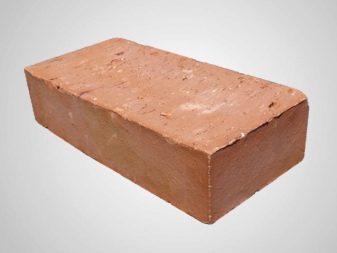
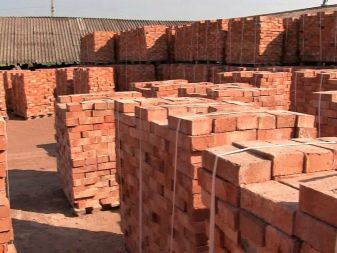
Silicate and clinker
These bricks are subspecies of ceramic, and are produced using a special technology. Refractory clays are used for their manufacture, which are superimposed into molds in layers and mixed with each other. The firing of such a product is carried out at a temperature of 1200 degrees, and the process of exposure to high temperature continues until the layers are sintered, as a result of which an inseparable bar is obtained. The color of the material may vary depending on the type of clay.

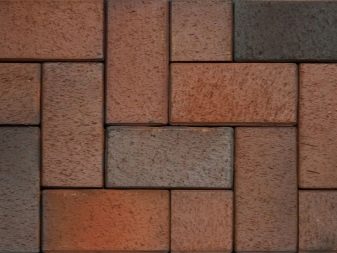
The advantage is high thermal conductivity, and the disadvantage is high weight. The disadvantages include the high cost and complexity of manufacturing. Usually this type of brick is used for the device:
- steps;
- columns;
- pillars;
- tracks and stuff.
Silicate brick is used as a facing or ordinary material. It is made from quartz sand, lime and additives. In order for the material to obtain the desired color, pigments are added to it, which improve the characteristics, and also change the color. As a result, it turns out:
- white;
- blue;
- green;
- purple and so on.
This type of brick stands out for its attractive appearance, therefore it can often be used in the form of facing. Since this product is made full-bodied, it weighs quite a lot, which excludes the possibility of high-rise construction with its help, therefore it is often used for the construction of low-rise buildings. In addition, the use of this type of brick requires the creation of a strong and solid foundation.

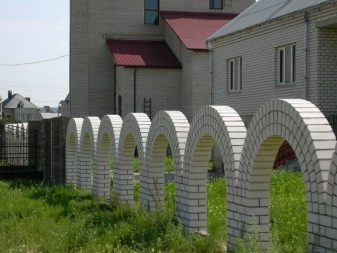
Recommendations for installing facing bricks with your own hands
The process of installing facing bricks is not too different from the process of laying ordinary building bricks, but there are still some nuances that you should pay attention to in advance:
- before you finally lay all the bricks using mortar, you need to lay them out "dry" to make sure that the masonry is uniform. This must be done because the non-standard dimensions of bricks (ceramic or any other), which are almost always found in a batch, did not spoil the appearance of the facade;
- if there is a need to reduce the length of the brick, then for cutting you need to use a grinder with a specially designed disc for this;
- the mortar on which the bricks are laid can be the same as for laying ordinary bricks. The only condition is that the sand must be pre-sieved;
- if you want to decorate the wall in a single color scheme, you can add color components to the composition of the solution;
- ideal joint size between facing bricks for vertical up to 12 mm, for horizontal up to 10 mm.

Shotcrete clinker brick
Important! It is strictly forbidden to use a disc designed for working with metal for cutting bricks. This can negatively affect the brick, making it unsuitable for further use, and also lead to a malfunction of the cutting blade itself.
In general, in order for the wall to end up having an attractive appearance, special attention must be paid to the formation of gaps. To do this, laying must be done in such a way that the solution does not reach the edge by 10-15 cm
To achieve this easier, you can use a special template that allows you to quickly and easily cope with the task.
Another secret that everyone who undertakes an independent wall cladding should know is the need to ensure the air permeability of the masonry. To do this, leave every fourth vertical seam empty, without filling it with mortar. Due to this technique, the air will be able to circulate freely and the humidity will be regulated.
If, during work, a solution gets on the front side of the brick, it must be removed immediately to prevent drying out. Since the material reacts fairly quickly with an alkaline solution, it may not be possible to completely remove the stain in the future.

Facade of the building with terracotta-colored facing bricks
Having become familiar with the whole variety of facing bricks, as well as their sizes, prices and characteristics, each home owner can choose the highest quality and most suitable option for decorating his facade. Of course, when choosing, you have to focus not only on the appearance of the material, but also on the price of finishing bricks for the facade. However, it is quite possible to find an attractive and inexpensive option that will satisfy all your wishes.
Application
Facing brick is the most common and popular type of ceramic counterpart. It has found its application in the interior and exterior decoration of the facade of the building. It is used for the construction of load-bearing columns, the construction of fences.
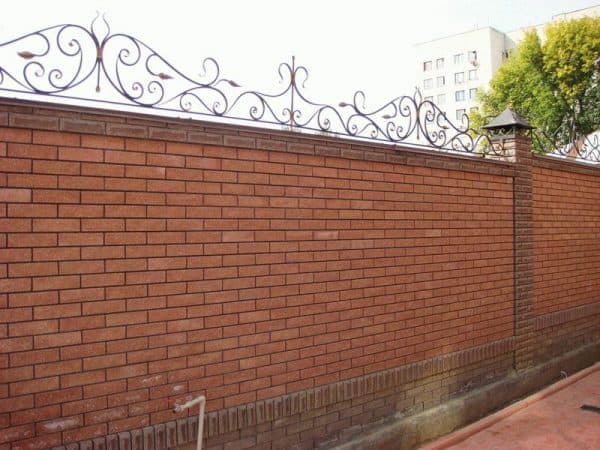
Fence
Facing briquettes have found their application in the improvement of adjacent territories. They are actively used by architects and landscape designers who are not afraid to embody even the most diverse ideas.
The use of plaster has already faded into the background, because it requires increased attention and care. Otherwise, the constructed building will have an unpresentable appearance, moreover, the plaster will begin to crumble over time.
At the same time, repairs and constant maintenance of the external facade requires a lot of money. This problem can be easily and cheaply solved by using brick for the first time in the facing of the property. It is considered to be a fairly durable building material that does not require any additional maintenance.

Facade
Today, modern technologies are actively developing and red facing bricks are able to embody any decisions of architects and designers with their original projects.
But when working with bricks, and especially when it comes to facing, it is worth remembering that it is advisable to use only the material that was produced in one batch. Then all the briquettes will be not only the same color, but also the shade.
Also, always consider the main rules when laying facing bricks in order to obtain a predominantly good contrast between the shade of the material and the color of the mortar:
red facing brick should be combined with black mortar;

Black solution
facing bricks of brown and gray colors are harmoniously combined with snow-white mortar.
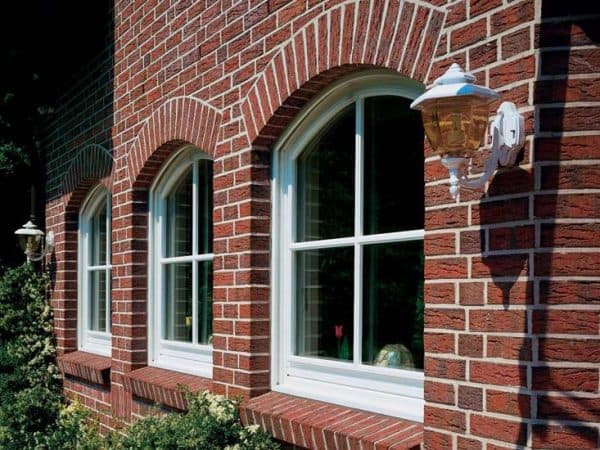
White solution
The building briquette differs significantly from the facing one. And not only here external characteristics are taken into account, technical features are also important.
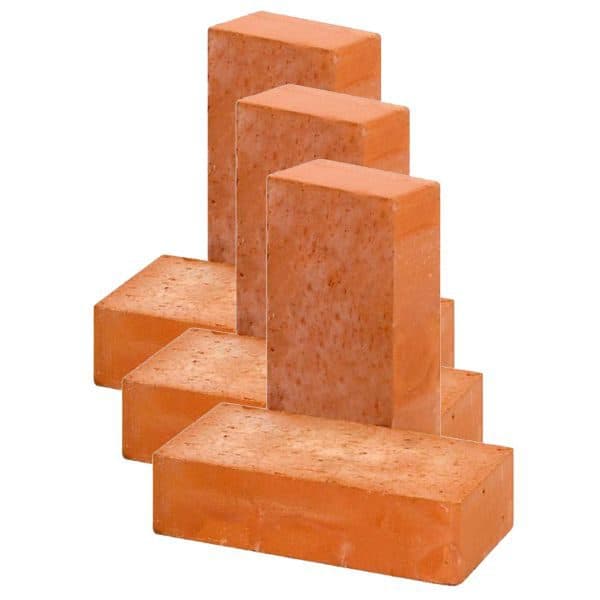
Building
For facing work, hollow or porous briquettes are most often used. The use of the former is extremely rare.
In addition to improved appearance, this briquette stands out for its resistance to subzero temperatures and strength.
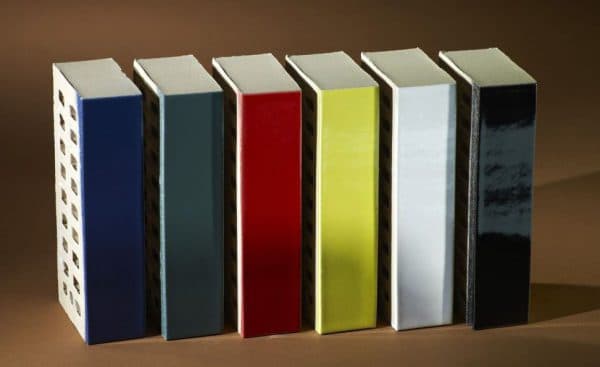
Glazed
In addition, it is rational to use a relief analogue. Such bricks are produced in figured and shaped, in addition, they give the facade an original and memorable look. The material considered in the article is often used for decorative purposes for interior decoration.

Shaped
In addition, it stands out for its practicality in operation - you just need to correctly choose the material from the whole variety of color palette, trust the masters. As a result, any room in this design will become nontrivially aesthetically perfect.
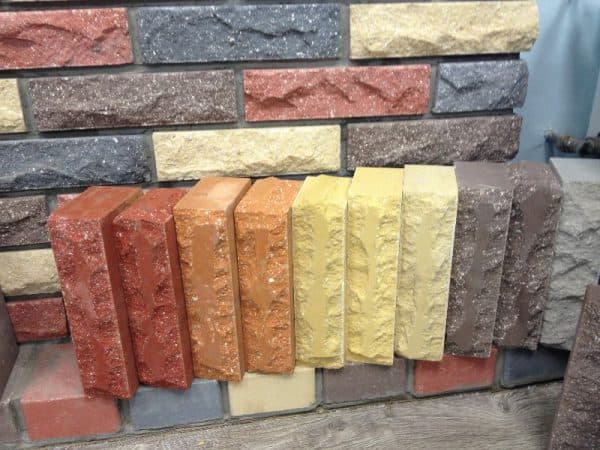
Hyperpressed
Due to the unique production technology, this type of material for the construction of load-bearing structures stands out not only for its aesthetic external characteristics, but also for the established dimensions. Do not forget about the high performance characteristics.
Choice
Many shapes and sizes can be found on the market today. Most often, buyers opt for:
- wedge-shaped or trapezoidal;
- twisted or curly.
- models with beveled corners or on gourd-shaped briquettes.
Today, facing brick with a pair or one beveled corner is considered the most popular.
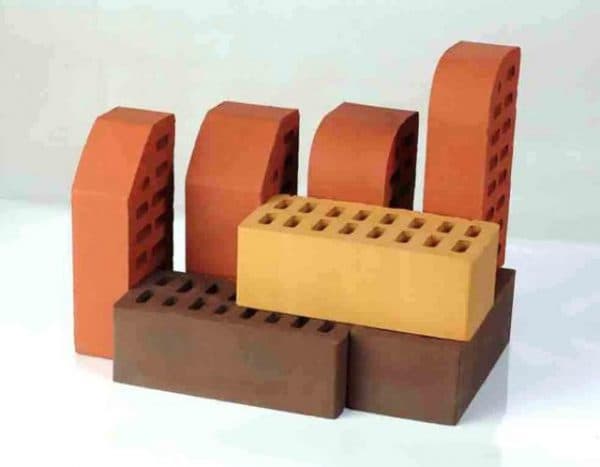
Beveled corner
In second place is a curly "pumpkin" or the brick that is identical to the "wild stone". Usually, the choice of one or another available option is based on the purpose of construction. For an option on a limited budget, non-fired material is ideal.
The ceramic counterpart will embody the most original ideas. And the maximum strength is achieved when using the clinker type.
But these are not all pluses.Thanks to its improved absorbent and filtering properties, facing bricks keep out many harmful bacteria that can enter your home.
Dimensions (edit)
Experienced builders know exactly the size of a red full-bodied brick, this is important when calculating the estimate, as well as determining the joint, planning the foundation, etc., the size can be viewed visually in the photo. Today the stone is divided into standard and non-standard
Standard refers to the usual single brick, which can be found in most areas of construction.
Today, the stone is divided into standard and non-standard. Standard refers to the usual single brick, which can be found in most areas of construction.
The size of ordinary solid red brick is strictly regulated by GOST, which excludes significant defects or deviations from various manufacturers.
This option is the most convenient and popular today, as it allows you to lay even wide masonry panels and walls without any problems.
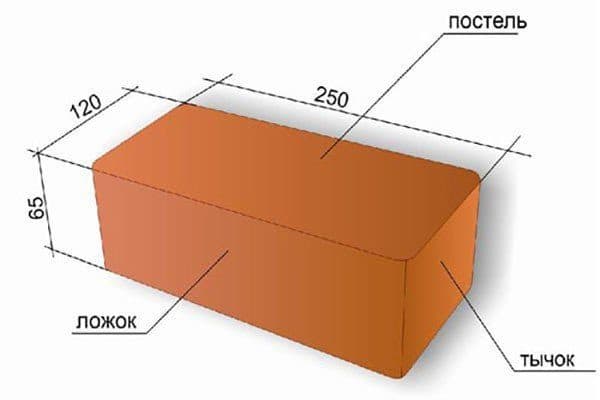
Standard
If you delve into the dimensions a little, it becomes obvious that its dimensions are almost 2 times smaller in each of the following parameters.
Due to the fact that the width is almost 2 times less than the length, it is possible to make cross-laying when the brick is laid perpendicular to the previous layer. This approach is actively used in construction and helps to increase the quality characteristics of the structure.
The alternation occurs at a certain frequency, it can be after 1 row or after 3 rows, it is already determined by the contractor on the spot.
This is done to ensure maximum masonry convenience in specific industries. Such a specific stone is called one and a half. Its basic characteristics, that is, the length and width remain the same, recall 250x120 mm, but the thickness increases slightly.
For one and a half red brick, the dimensions will be 250x120x88 mm, that is, the thickness of the stone is 23 mm larger than that of a standard single brick.

One and a half
There is another brick, it is even more thickened in cross-section in thickness, such a stone is called double.
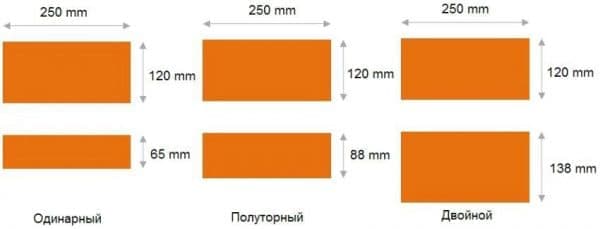
Double
The size of the brick, in addition to the popular and well-known varieties in our area, may correspond to other standards. Today the euro brick is gradually entering the market, slowly but surely. Its main difference is its small width, namely 2 times smaller than the standard one.
Its dimensions are 250x60x65 mm. It is used infrequently for the construction of houses, since it is associated with high expenditures of man-hours, but it is often produced as a facing, it makes it possible to lighten the structure. It is noteworthy that the euro standard is rarely used in Europe itself.
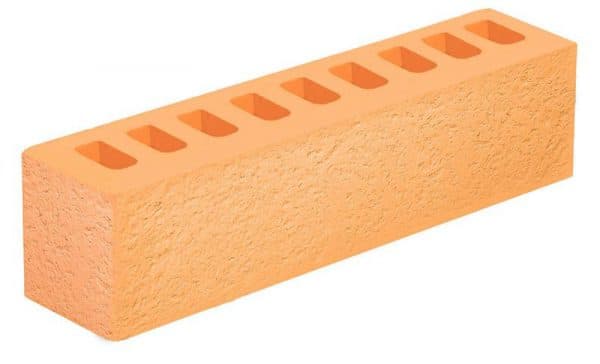
Euro
Uncommon, but some manufacturers can make other types of bricks, mostly made to order. Such uncharacteristic dimensions are rarely used, only for projects that require certain complex types of work.
In most cases, decorative types of bricks have distinctive characteristics.

Facade
Until now, there are craftsmen who prepare red bricks by hand, this is mainly done with the aim of giving them a specific aged look. Today there are very few workshops left; there are none at all on the territory of Russia.
Sizes can vary significantly depending on the type and production process, it is worth checking individually. The scope of application in most cases is limited to restoration work.
Assortment of red facade bricks
Red brick for cladding is not
a separate type of building material. Depending on the component part, it is divided
into subclasses. The description below will help you better understand
assortment.
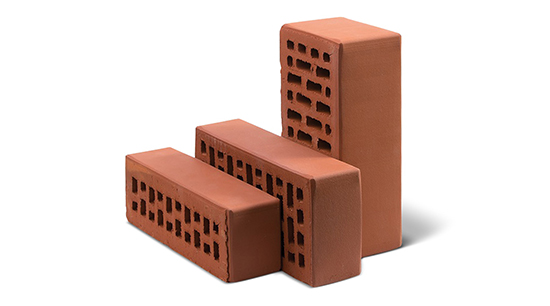
Ceramic
A popular type of finishing brick, it
made from clay. The material undergoes high-temperature firing. Building material
has a rich, even color that indicates high quality
product. Ceramic has many advantages due to its loose bulk
structure, the brick allows oxygen to pass through and serves as an additional insulation
front part. Light weight enables easy transport and loading
on the foundation will be minimized. Building units do not float when stacked
on the solution.
Clinker
It is very similar to ceramic products as it is produced from the same raw materials and using a similar technology. The main difference is that during roasting, the temperature regime is much higher, the raw material is heated to the melting point. The result is a particularly durable and moisture resistant element. This feature is both a plus and a minus.
In practice, resistance to humid environments ensures durability and frost resistance. But the lack of water absorption qualities reduces the adhesion of the cement composition with the surface layer, the bricks do not keep the row as it should. In such a situation, it is required to introduce special means into the composition.
Silicate
The brick is made from natural components with the addition of red pigment, has high sound insulation, density and frost resistance. The composition of silicate products includes sand, lime and a small proportion of additives. The raw materials are placed in a unit designed for heating under pressure, the indicators of which exceed atmospheric.
Pressure plus heat creates a silicate compound. This type of brick product is environmentally friendly. In terms of technical and economic indicators, it is ahead of ceramic products. The production takes from 15 to 18 hours, and the production of bricks from the clay composition takes 5-6 days.
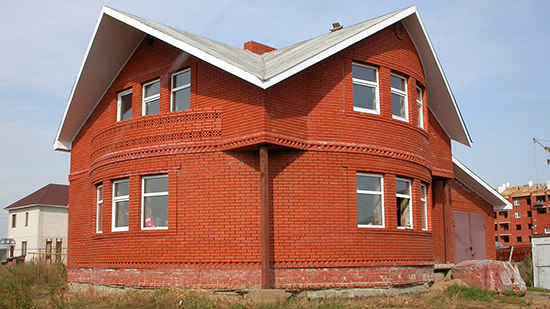
Hyperpressed
Made from cement with the addition of limestone. By
the technology of composition firing is not provided. The formed material solidifies under
the weight of the press. The product turns out to be full-bodied, thanks to this quality
the load on the supporting and supporting structures of the building increases. It is because of
this feature and a higher price, the demand for hyper-pressed
elements. They have clear and even geometric shapes, and the front part
often made in a form that repeats the texture of natural stone.
The most popular brick colors and textures: facing for every taste
The color of the fired clay itself is quite bright and attractive and is often the preferred color. It is the natural colors that are in the greatest demand and have held the leading position for many years. But still, other options are used.
The most popular color range of facing bricks
It is very easy to give the surface of the facing brick the desired texture. To do this, a textured pattern is applied over the not yet solidified element, after which the element is sent to the oven.
But this is far from the only way to design and decorate the surface of facing bricks. So, along with the main one, the following technologies are also used:
- shotcrete - the process of applying mineral chips to the surface of a brick;
- engobing - the application of a special composition, which, under the influence of high temperature, provokes the appearance of a glassy film;
- glazing is a process slightly similar to the previous one, with the exception that the composition that is applied to the surface forms a film of greater thickness and strength.
Each of these options is worthy of consideration and can be used in the process of facing work. Moreover, bricks designed using various methods can be combined with each other, making out with their help individual sections of the facade, doorways, etc. This will avoid monotony in the design.
Black cladding brick is a rather popular solution for cladding modern or high-tech buildings.
Available colors of facing bricks from various materials
The color of ceramic bricks depends on how much and what kind of additive was mixed into the raw material, as well as on firing. Therefore, we often have to deal with the fact that in different batches the bricks have slight differences in color. In order for this not to be striking and not to spoil the appearance of the wall, it is recommended to take bricks from different batches one by one. So, the color of the surface will be as uniform as possible.
If we talk about the colors of ceramic bricks, then it really is represented mainly by red and brown shades. But on the other hand, their variety is so great that the choice is simply impressive.
But hyper-pressed bricks, in the manufacturing process of which there is no firing, are painted in the desired color by adding pigment to the raw material. This allows you to produce uniform coloring throughout the product and avoid color mismatches in different batches. The most popular are concrete bricks of white, black, pistachio, brown, red, peach, gray, chocolate and blue colors. And those who like non-standard solutions can consider ivory, straw, terracotta and even green.
Concrete bricks can have different color shades
According to the same principle as hyperpressed, silicate bricks are painted. The pigment is added during the mixing of the solution using a special dispenser.
Important! Too much paint in the composition of the solution can negatively affect the strength of silicate bricks, therefore, for this type of product, they often resort to painting only one side. Among the main colors of silicate bricks, it is worth noting white, pink, yellow, orange, gray purple
Among the main colors of silicate bricks, it is worth noting white, pink, yellow, orange, gray purple.
Brick packing options
Before calculating how many bricks are on a pallet, let us briefly return to the issue of bulk transportation, since many are interested in whether this can be done or not. We will not invent anything about this, but turn to the current standards - they have a chapter: "Transportation and storage".
GOST 530, which regulates the manufacture of ceramic products, clearly states that loading and unloading cannot be carried out in bulk.
Extract from GOST 530 * 2012
In GOST 379, according to which silicate brick is made, its transportation in bulk is permissible, but only if the customer agrees to this.
Extract from GOST 379 * 2015
As you can see, some relaxation is made for sand-lime bricks, but in general terms the requirements are the same - the brick must be transported in pallets. They, of course, cost money, which is why some customers tend to do without them, using a good old dump truck for transportation.
If the client does not mind, sand-lime bricks can be loaded into a dump truck
For ceramic bricks, the maximum is transportation by onboard vehicle with do-it-yourself unloading
But the best thing is loading pallets with a manipulator
For those who need to transport clay products and at the same time save on pallets, there is only one way out: to fold the bricks manually on the flatbed truck, as shown in the photo. But in this case, you will have to sweat a lot, first when laying, and then when unloading.
For most sane people, such a game is not worth the candle. They adhere to the golden mean, and transport the brick to the site as it should be according to the standard. It remains only to decide how many bricks are in one pallet, and what they are.

